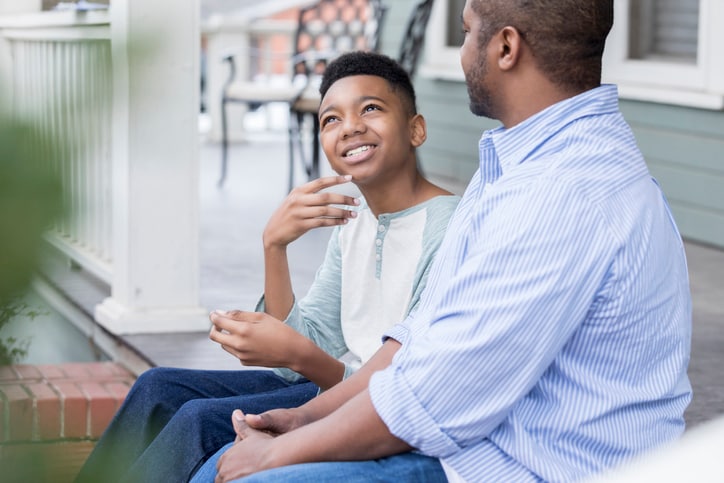TikTok has done a particularly effective job at helping to shine light on certain familial conflicts that, up until the app’s creation, primarily occurred behind closed doors. Case in point: The platform has a wealth of commentary on how parents can set boundaries with grandparents. And for good reason, experts say.
“Setting boundaries, along with setting realistic expectations, are two of the top things that multigenerational families can do to help setting up this living arrangement for success,” explains Sid Khurana, M.D., a board-certified adult, child and adolescent psychiatrist.
Anton Shcherbakov, co-founder of ThinkPsych and licensed clinical psychologist, adds, “Setting boundaries is how we communicate what we are willing and not willing to do with or for others. When we don’t clearly set our boundaries, we can end up feeling taken advantage of, disrespected or hurt by others.”
Here, TikTok creators offer valuable lessons on setting boundaries with grandparents.
1. Boundaries isn’t a dirty word
As Lisa Pontius, who goes by itsme_lisap on TikTok, describes in her video, her grandparents see her children frequently for one very important reason: They respect boundaries — which, by the way, is “not a dirty word.”
“I still have boundaries with my parents in regards to my children,” she says. “They still have boundaries with me with how much and how often they’ll watch said grandchildren. We each acknowledge and respect each other’s boundaries.”
In other words, Pontius and her parents rely on very firm, concrete communication to express wants, needs and any frustrations.
Shcherbakov agrees with Pontius’ take, pointing out, “Boundaries are very important in all relationships. For example, a grandparent may expect that they can drop by anytime to see you. You may need to clearly explain to them that your boundary consists of a reasonable notice before a visit and the opportunity to say no when it is inappropriate or inconvenient for you.”
He adds that addressing a violated boundary immediately is critical in remedying it for the future. “You may need to explain reasonable consequences if the boundary is violated,” he says, such as potentially denying them entry. It may sound rough, he says, but sometimes a bit of firmness can be the only way to accurately communicate a need.
2. Access to loved ones is a privilege
As TikTok creator truthheals outlined in her video, just because a person is a grandparent, doesn’t mean they have automatic rights to their grandchildren. Access to family is a privilege, she says. “Very likely, the proximity to your grandchildren reflects the dynamic and relationship you have with your adult children,” she says. “If you love, care for and miss your grandchildren, you may want to start with the source: your children.”
Shcherbakov explains, “The hallmarks of a healthy relationship between a grandparent and adult child are the same as those for any relationship: open communication, mutual respect and trust.”
However, in an unhealthy relationship, those qualities are reversed, he says. “Communication is marked by invalidating feelings, blaming or intimidating the other person,” says Shcherbakov. “There is a lack of trust or respect for one another’s boundaries. In short, when you end the interaction with the person, you often feel worse than you did before you began.”
3. Communicate, communicate, communicate
TikTok user gwenith_rachelle, a grandparent herself, never watches her grandchildren without full, detailed instructions on care. “I ask them for their instructions on [my grandchild’s] routine with bottles, foods, anything. I ask permission. I respect them as parents,” she tells viewers. “There’s no quicker way to disrespect your grown adult children than to have that mentality of I’ve had kids so I know what I’m doing.”
Dr. Khurana notes that this approach — calmly and respectively attempting to understand your adult child’s caregiving practices and wishes — is an enormous step in a healthy, multi-generational relationship. “When things go wrong (and they do wrong), maintaining calm and mutual respect and sticking to the fundamentals of good interpersonal communication is the key in not straining relationships further,” he explains.
Whether it’s settling on a bedtime, choosing what snacks to feed the youngsters or even establishing babysitting days and times, take a collaborative, solutions-focused approach, says Dr. Khurana — sans the emotions.
4. Agree to a finite gift-giving routine and establish rules around toys
In this role-play video, TikTok user diaryofanhonestmom illustrates how grandparents disregarding a parent’s wishes via selective hearing can cause frustration in the relationship. She mimics telling a grandparent to only buy a single gift for her child on Christmas. The grandparent in question agrees, then, brings a trove of goodies on the actual holiday. The TikTok creator ends the video with the classic Taylor Swift song lyric: “Maybe we got lost in translation.”
As Dr. Khurana explains, grandparents may (inadvertently or on purpose) cross boundaries the most when it comes to gift-giving or toys. “Allowing grandchildren a different set of rules, allowing them to not follow parents’ rules and undermining parents’ attempts to enforce rules by interfering are all ways grandparents can cross boundaries,” he says.
The solution, he notes, is communication.
“When things are calm and normal, those are the times to communicate to establish these boundaries by seeking the input from both generations, keeping judgements out of those conversations and being receptive to feedback and demonstrating flexibility in agreeing to the expectations/boundaries,” says Dr. Khurana. “Certain situations are going to entail being patient, understanding and flexible.”
5. Use “I statements” as much as possible
For TikTok creator opal_wells, relying on calm reiterations of family standards and using “I statements” as frequently as possible helps her establish firm boundaries with grandparents.
“Actually, we have a system of treats. Can I explain to you what it is and then we can all be on the same page?” the creator poses in a role-playing skit in her video.
In another, she adds, “I know you’re coming from a good place here. I know it can be fun to shower your grandchildren with love and spoil them. But we’re not really on the same page right now and it’s causing them some confusion. So can we talk about this and get on the same page?”
The creator ends the clip on a particularly effective expression about the importance of unique family practices: “You are so capable and I know that it feels a little weird that we do things differently than how you did them. But this is how we do things in our family and I do need you to respect it.”
Relying on “I statements” is one of Scherbakov’s favorite tactics for communicating boundaries in a non-defensive, non-accusatory way.
“Utilize ‘I statements’ to focus on your needs and the needs of your family,” he suggests. “For example, if you have a grandparent that insists on giving unsolicited parenting advice, you can say, ‘When you give me parenting advice, it makes me feel like I’m not doing a good job with my child. It would make me feel more comfortable and enjoy having you visit more if you could refrain from giving parenting suggestions. It’s hard to be a parent, and I’m doing the best I can.’”
Dr. Khurana says that a parent-adult child relationship must be built on mutual respect and trust. And lacking trust, boundaries make it possible to maintain a multigenerational relationship that still feels safe for everyone involved.




